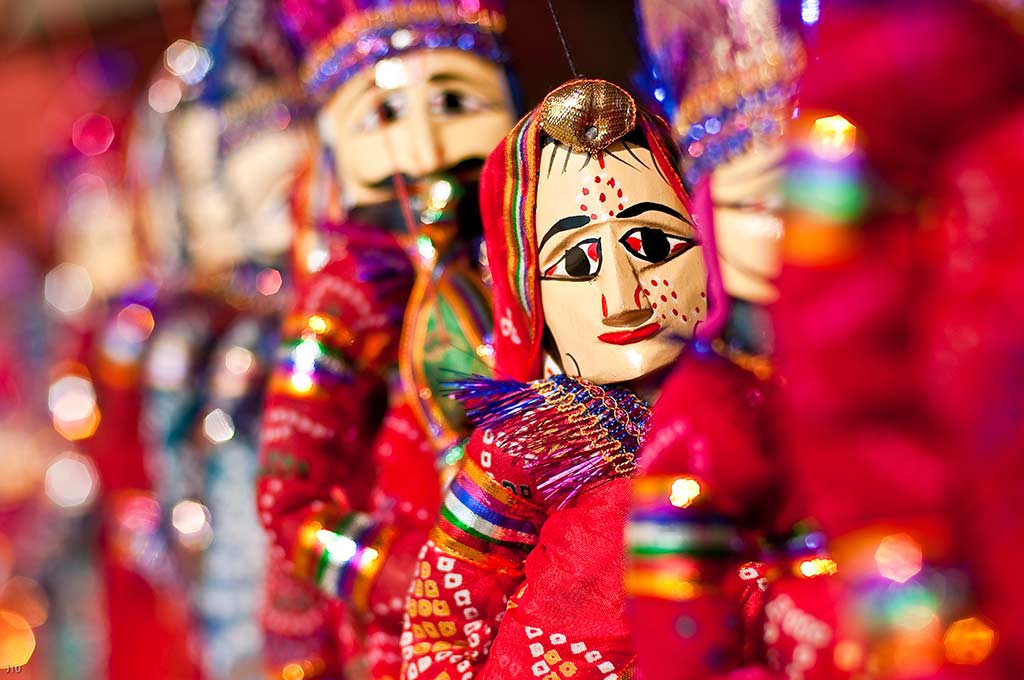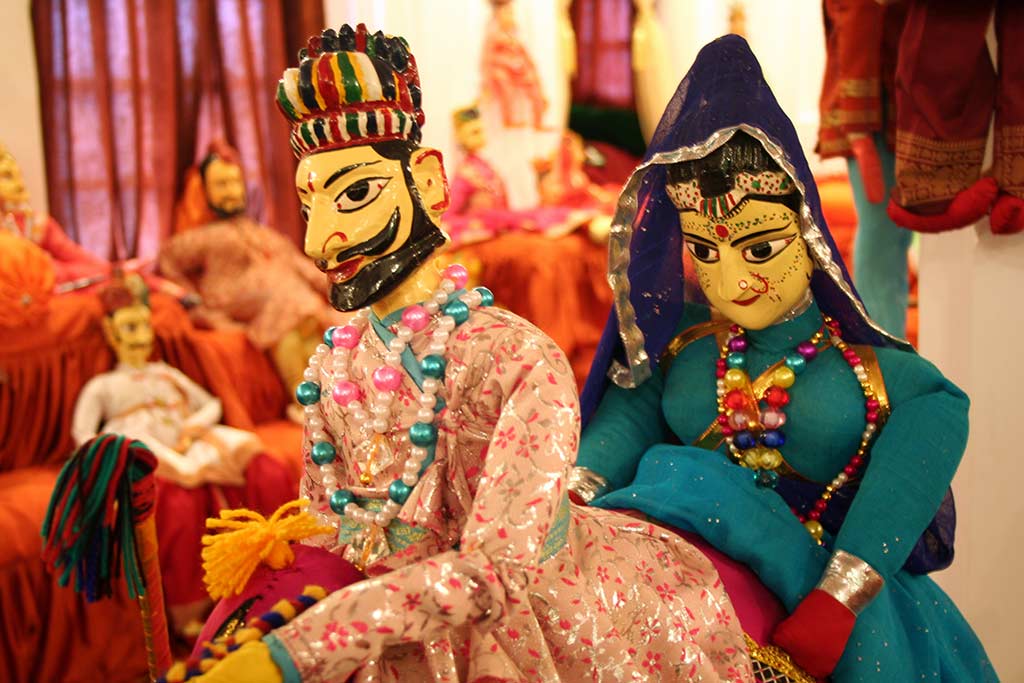Stringing Along
A short block of wood and a single string; a puppet and a puppeteer; a story and a performance; and the stage and the audience – tracing the journey of the ‘kathputli’, a traditional form of puppetry from Rajasthan, and its history of relevance
Vrinda Baliga
The stage is set. The curtains part, revealing a line-up of performers who stand with their backs to the audience. The music starts, and the narrator launches into the opening verses of the ballad of Amar Singh Rathore of Nagaur. On stage, the performer playing the eponymous Rajput warrior whirls around to face the audience, wielding his sword and shield with a flourish. The audience sits rapt. It could be a play being performed in any theatre in the country. Except, the stage is a miniature one, held in place by bamboo rods, and the actors on stage are hardly over a foot tall. They are kathputlis, wooden marionettes painted with human faces and adorned in traditional Rajasthani attire.
As the story of Rajput valour unfolds on stage, though, it is easy to forget that the actors on are not human. As far as the audience – and perhaps even the string puppets themselves – are concerned, they are every bit as alive and sentient as any human actor. And this is thanks to the amazing skill of the puppeteers who, hidden from the audience’s view by the stage backdrop, dexterously manipulate the strings that breathe life into the puppets. Even when the show ends and the audience bursts into applause, the puppeteers are content to remain in the background, letting the kathputlis take a bow.

Puppetry is an art form believed to be nearly 4,000 years old. Evidence of puppetry has been found in many ancient civilisations in Egypt, Greece, China and the Indus Valley. In India, the earliest known references to puppetry have been traced back to the ancient epic Mahabharata and to the works of the renowned Sanskrit grammarians, Panini and Patanjali, that date back to the 5th century B.C. and 2nd century B.C. respectively. Puppetry also finds mention in the Tamil epic Silappatikaram written around the beginning of the Christian era. In Bharata’s Natyashastra, an ancient treatise on the performing arts compiled somewhere around 200 BCE, the director of classical Sanskrit plays is tellingly referred to as the ‘Sutradhar’, ‘the bearer of strings’, that is, the person who holds the strings and manages the actors’ performance from behind the scenes.
Many forms of puppetry have flourished in India like shadow, glove, string and rod puppetry. Kathputli is a form of string puppetry that traces its origins to Rajasthan. The word kathputli is derived from ‘kath’ meaning ‘wood’ and ‘putli’ meaning ‘doll’. Puppeteers traditionally travel from village to village, performing at fairs, festivals and ceremonies. Popular themes for kathputli shows are stories from the Mahabharata, Ramayana and the Puranas, as well as local myths and folklore. Ballads and tales of Rajput bravery are also common and well-loved themes. Once patronised by Rajasthani rulers and nobles, the art form saw a decline under the Mughals. However, puppeteer communities such as the Bhats of Rajasthan have kept the kathputli tradition alive, passing it on from generation to generation.
Some of the usual suspects of a kathputli show are the king (raja), queen (rani), dancing girl (anarkali), snake charmer (sapera), magician (jadugar) and an entourage of courtiers and sword-bearing warriors, often on horse or camel-back. Irrespective of which of these it ends up as, a kathputli invariably begins life as a short block of wood. That piece of wood is carved and chiseled into a head, arms and torso. A face is then painted on with prominent eyes, eyebrows, nose and lips. The wood work is usually done by the men of the puppeteer community, after which the carved puppet is turned over to the women who make its clothes and jewellery. Pagdis and kurtas for male puppets, bright-coloured cholis and odhnis and wide ghagra skirts for female puppets are the norm. The puppets usually have no legs, and this is hidden from the audience by their flowing lower garments. The strings are then attached, depending on the type of movements and flexibility required of the puppet. And then, the kathputli is ready for its first performance.

The percussion beats of the dholak, the beautiful strains of the ravanahatha (a traditional string instrument) and the sonorous tones of the harmonium typically accompany kathputli performances. And while the puppeteer pours life into the kathputli’s limbs, it is the narrator, or bhagavat, who puts words into its mouth. It is the narrator who recites the kathputli’s story. The kathputli’s own ‘voice’ is typically represented by the shrill, sharp whistles and squeaks of a bamboo reed instrument called the ‘boli’, and this is interpreted for the audience by the narrator. The kathputli performance is an intimate experience, usually presented before a small audience who sit close to the stage, at eye-level with the puppets. Thus, every intricate move – the anarkali picking up the ends of her ghaghra in dance, the snake swaying in tune to the sapera’s been, the warrior’s deft swordsmanship – can be closely observed and appreciated.
Like many traditional art forms, kathputli too faces many challenges. However, kathputli is a versatile art form that has managed to adapt to the changing environment admirably, while clinging tenaciously to its ancient roots. Modern themes and socially relevant messages are now woven into performances, in addition to the traditional ballads and stories. Thanks to its enduring appeal, especially in rural communities and with young children, kathputli is also a potent means of taking awareness campaigns about social evils, health and hygiene to a wider audience in a non-threatening, relatable and an inoffensive manner.
At the end of the day, however, it is the enduring bond between puppet and puppeteer, held together by strings of love, dedication and immense skill, which has kept this ancient art alive till today.
Share